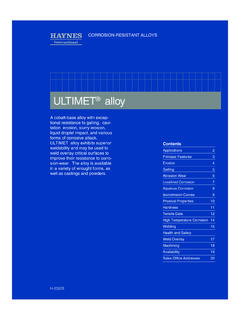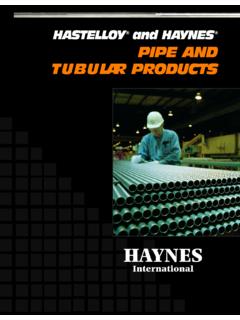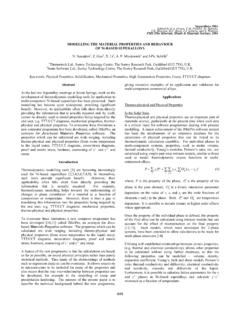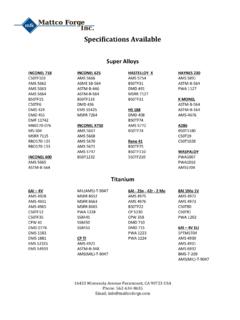Transcription of HAYNES 214 alloy - INKOSAS
1 ContentsTypical Applications2 Principal Features3 Oxidation Resistance4 Carburization Resistance7 Resistance to Chlorine-BearingEnvironments10 Nitriding Resistance11 Physical Properties12 Modulus of Elasticity13 Tensile Properties14 Creep and Rupture Properties15 Thermal Stability16 Fabrication Characteristics16 Welding17 Health & Safety19 Sales Office Addresses20A nickel-chromium-aluminum-iron alloy with outstandingresistance to ALLOYSHAYNES 214 alloy2 HAYNES 214 alloyAPPLICATIONSThis 214 alloy flamehood remained in service for16 months in an application where other nickelalloy hoods required replacement every three tofour months. The alloy component was subjectedto direct flame impingement during the entireperiod in an automotive products plant. 1996 HAYNES International, 214 alloy is gaining rapid accep-tance for use in honeycomb seals because of itsoutstanding oxidation resistance. The seals aremade of thin gage foil and are used to preventleakage between different stages in gas turbineengines.
2 Such seals contribute to an engines burner assembly at left failed after 450 cyclesbetween minus 55 and 2000 F (minus 50 and1095 C.) A 214 alloy burner was still in goodshape after 2000 cycles in the same test. Theburners were cycled from low to high tempera-tures in about five minutes, held for a 15-minuteburn, and then rapid-air of a 214 alloy belt which was removedafter 3,000 hours at 1800 F (980 C) in achinaware decorating kiln. The belt showed onlyminimal wear and oxidation attack. Use of 214alloy in this application has helped reduce thetime of the operation from eight or twelve hours,to less than 30 FEATURESA vailable Product FormsHAYNES 214 alloy is available in theform of plate, sheet, strip, billet, bar,and SpecificationsHAYNES 214 alloy is covered by DINspecification number 17744 all forms, and a full range ofHaynes internal product consult HAYNES Internationalfor 214 alloy combines proper-ties which make it very suitable forservice in relatively low-stress, high-temperature oxidizing environments,where the utmost in resistance tooxidation or scale exfoliation isneeded.
3 Its resistance to suchenvironments persists to temperaturesas high as 2400 F (1315 C), althoughstrength limitations may can include "Clean Firing"uses such as mesh belts, trays andfixtures for firing of pottery and finechina, and the heat treatment ofelectronic devices and technical the gas turbine industry, 214 alloy isused for foil construction honeycombseals, combustor splash plates, andother static oxidation - limited automotive industry has applica-tions for 214 alloy in catalytic converterinternals, and it is used as a burnercup material in auxiliary heaters formilitary the industrial heating market, 214alloy is used for highly specializedapplications such as refractoryanchors, furnace flame hoods, androtary calciners for processing chloridecompounds. It is also used for parts inhigh temperature chlorine-contami-nated environments, such as hospitalwaste incinerator OxidationResistanceHAYNES 214 alloy is a nickel-chromium-aluminum-iron alloy ,designed to provide the optimum inhigh-temperature oxidation resistancefor a wrought austenitic material, whileat the same time allowing for conven-tional forming and joining.
4 Intendedprincipally for use at temperatures of1750 F (955 C) and above, 214 alloyexhibits resistance to oxidation that farexceeds virtually all conventional heat-resistant wrought alloys at thesetemperatures. This is attributable tothe formation of a tightly adherentAl2O3-type protective oxide scale,which forms in preference to chromiumoxide scales at these high tempera-tures. At temperatures below 1750 F(955 C), 214 alloy develops an oxidescale which is a mixture of chromiumand aluminum oxides. This mixedscale is somewhat less protective, butstill affords 214 alloy oxidationresistance equal to the best nickel-base higher temperature Al2O3- typescale which 214 alloy forms alsoprovides the alloy with excellentresistance to carburization, nitridingand corrosion in chlorine-bearingoxidizing 214 alloy is similar in manyrespects to high aluminum contentnickel-base alloys which are intendedto be age-hardened by intermediatetemperature heat treatment.
5 Ifexposed at temperatures in the rangeof 1100-1700 F (595-925 C), 214 alloywill exhibit age-hardening as a result ofthe formation of a second phase,gamma prime (Ni3Al). This also resultsin a significant loss of intermediate andlow temperature tensile ductility. As aconsequence of this, 214 alloy issusceptible to strain-age crackingwhen highly-stressed, highly- HAYNES 214 alloyrestrained, welded components areslowly heated through the intermediatetemperature regime. This behavior isthe same as that exhibited by highaluminum + titanium content superal-loys, such as Waspaloy or R-41 keys avoiding this problem are tominimize weldment restraint throughappropriate component design, and/orheat rapidly through the 1100-1700 F(595-925 C) temperature range duringpost-fabrication heat treatment (or first-use heat up).With the exception of the aboveconsideration, HAYNES 214 alloydoes exhibit good forming and weldingcharacteristics.
6 It may be forged orotherwise hot-worked, providing it isheld at 2100 F (1150 C) for a timesufficient to bring the entire piece totemperature. Its room temperaturetensile ductility is also high enough toallow the alloy to be formed by cold-working. All cold or hot-worked partsshould be annealed and rapidly cooledin order to restore the best balance alloy can be welded by a variety oftechniques, including gas tungsten arc(TIG), gas metal arc (MIG) or shieldedmetal arc (coated electrode) 214 alloy is furnished in thesolution heat-treated condition, unlessotherwise specified. The alloy isnormally solution heat-treated at2000 F (1095 C) and rapidly cooled orquenched for optimum treating at temperatures belowthe solution heat-treating temperaturewill result in grain boundary carbideprecipitation and, below 1750 F(955 C), precipitation of gamma primephase. Such lower temperature age-hardening heat treatments are Chemical Composition, Weight * * * * As Balance * MaximumAverage Metal Affected in 1008 Hours**4 HAYNES 214 alloy providesresistance to oxidation attemperatures of 1750 F (955 C)and above that is virtuallyunmatched by any otherwrought heat-resistant alloy .
7 Itcan be used for long-termcontinuous exposure to com-bustion gases or air at tempera-tures up to 2300 F (1260 C),and, for shorter term exposures,it can be used at even highertemperatures. Useful short-term oxidation resistance haseven been demonstrated attemperatures as high as 2400 F(1315 C).OXIDATION RESISTANCEHAYNES 214 alloyComparative Oxidation Resistance in Flowing Air*Material214 alloy230 alloyalloy 600alloy 601RA330 alloyalloy 800 HType 446 SSType 316 SSMils **191** > >592> >3566 Mils > >551> >2667 Mils > >17372200 F (1205 C)2100 F (1150 C)2000 F (1095 C)1800 F (980 C)Mils *Flowing air at a velocity of feet/minute ( cm/minute) past the samples. Samples cycled to room temperature once-a-week.** Metal Loss + Average Internal Penetration** 601 Sample exhibited very large internal Technique used for Evaluating Environmental Tests1. Metal Loss = (A - B)/22. Average Internal Penetration = C3.
8 Maximum Internal Penetration = D4. Average Metal Affected = ((A - B)/2) + C5. Maximum Metal Affected = ((A - B)/2) + D5 HAYNES 214 alloyComparative Oxidation in Flowing Air 2100 F (1150 C)Microstructures shown are forcoupons exposed for 1008hours at 2100 F (1150 C) in airflowing at feet/minute ( ) past the were descaled bycathodically charging thecoupons while they wereimmersed in a molten saltsolution. The black area shownat the top of each picturerepresents actual metal lossdue to oxidation. The dataclearly show HAYNES 214 alloy is only slightly affected bythe exposure, while othernickel-chromium alloys , such asalloys 600 and 601, and iron-nickel chromium alloys , such asRA330 alloy , all exhibit signifi-cantly more oxidation particular importance is thealmost total absence of internalattack for the 214 alloy . Thiscontrasts markedly with thevery substantial amount ofinternal attack evidenced by thealloy 601 and RA330 alloy testscoupons.
9 The nature of thisinternal attack, as illustrated bythe photomicrographs, iscommon for alloys containing1-2% aluminum or silicon. Suchlevels of these elements dopromote chromium oxide scaleadherence, but do not affordimproved resistance to oxidepenetration below the 214 alloyAverage Metal Affected= Mils (8 m) alloy 600 Average Metal Affected= Mils (74 m) alloy 601 Average Metal Affected= Mils (135 m)RA330 alloyAverage Metal Affected= Mils (221 m)Comparative Burner Rig Oxidation Resistance* Metal Loss + Average Internal Penetrationa Extrapolated from 917 hoursb Extrapolated from 400 hoursc Internal penedtration through entire thicknessMils > >610cMils alloy230 alloyX alloyRA330 alloyalloy 600alloy 800 HType 310 Stainlessalloy 601 Mils F (980 C)/1000 Hours2000 F (1095 C)/500 HoursMetal LossAv. Metal Affected*Metal LossAv. Metal Affected*Oxidation Test ParametersBurner rig oxidation tests wereconducted by exposing, in arotating holder, samples x inches x thickness( x 64mm x thickness) tothe products of combustion offuel oil (2 parts No.)
10 1 and 1 partNo. 2) burned at a ratio of air tofuel of about 50:1. (Gasvelocity was about mach).Samples were automaticallyremoved from the gas streamevery 30 minutes and fan cool-ed to less than 500 F (260 C)and then reinserted into theflame 214 alloy6 Comparative Burner Rig Oxidation Resistance at 1800 F (980 C)/1000 Hours(Black areas of micros indicates actual metal loss) HAYNES 214 alloyAverage Metal Affected= Mils (25 m) alloy 601 Average Metal Affected= Mils (478 m)RA330 alloyAverage Metal Affected= Mils (300 m) alloy 800 HAverage Metal Affected= Mils (368 m)Comparative Burner Rig Oxidation Resistance at 2000 F (1095 C)/500 HoursHAYNES 214 alloyAverage Metal Affected= Mils (30 m) alloy 601 Average Metal Affected= > Mils (>610 m)RA330 alloyAverage Metal Affected= Mils (328 m) alloy 800 HAverage Metal Affected= Mils (848 m)7 HAYNES 214 alloyCARBURIZATION RESISTANCEHAYNES 214 alloy has verygood resistance to carburiza-tion, as measured in both pack-ed graphite exposure tests andmixed gas exposure for these tests arepresented in the followingpages.











![INDEX [www.brammerstandard.com]](/cache/preview/2/3/d/d/5/6/b/f/thumb-23dd56bf2c5253e5b1625a9af4865fc1.jpg)

